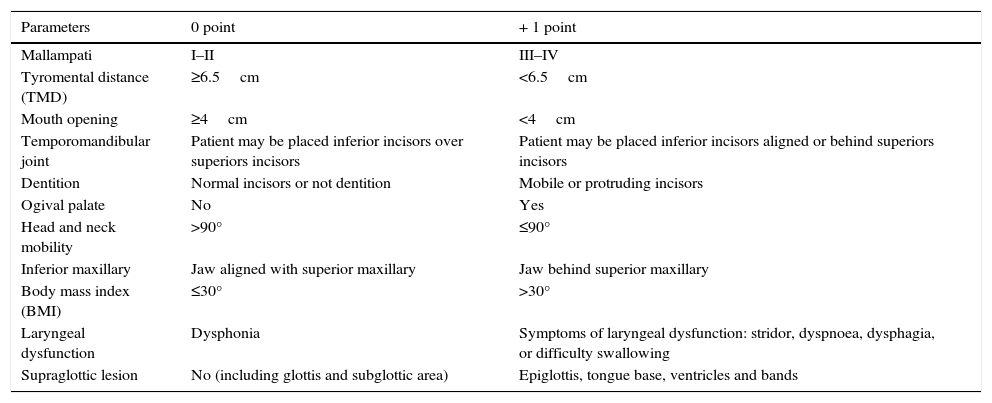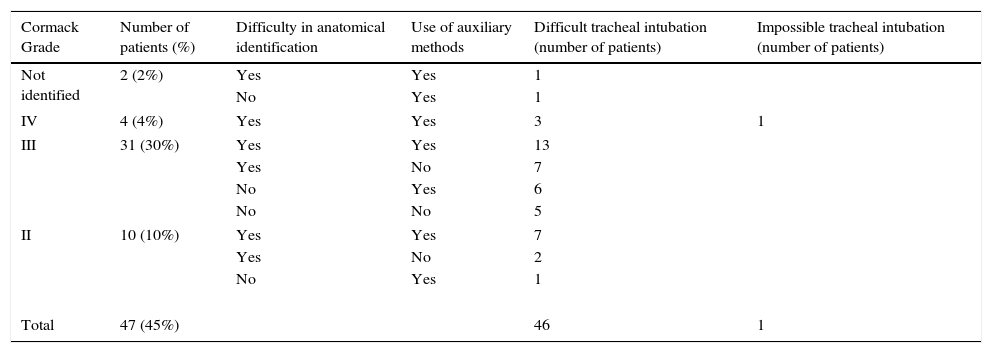In 2003 a simple test to detect difficult intubation (DI) in patients underwent laryngeal microsurgery was described. The present study was conducted to validate the test.
MethodsPatients with laryngeal disease scheduled for laryngeal microsurgery were included. The variables evaluated were eleven parameters: Mallampati Score≥III, thyromental distance<6.5cm, mouth opening<40mm, limitation of the temporomandibular joint, pathological dentition, arched paladet, maxillary deficiency, neck mobility<90°, body mass index, symptoms of laryngeal dysfunction, and tumour of supraglottic region. A rapid examination of the airway by an expert anaesthesiologist was carried out just before induction. DI was defined by a Cormack laryngeal view grade iii–iv and/or if auxiliary equipment was required to achieve orotracheal intubation. A comparison of ROC curves was conducted to estimate the best predicting cut-off, as well as differences between the index described in 2003 and the rapid assessment by an expert anaesthesiologist.
ResultsOne hundred and five patients were included in the study. The incidence of DI according to the predefined criteria was 45% (47 patients). The score at the cut-off of 5 provides a sensitivity of 89% and a specificity of 55%. The fast-evaluation by an expert anaesthesiologist obtained similar sensitivity (89%) and better specificity (81%). Area under curve (AUC) was 0.87, similar to a fast evaluation (AUC: 0.85; P=.71).
ConclusionThe index was validated at a cut-off of ≥5, being a useful and reliable test to predict DI in patients with laryngeal diseases and it is a useful tool for anaesthesiologists with conventional training.
En el año 2003 nuestro grupo describió un test simple para la detección de intubación difícil (ID) en pacientes sometidos a microcirugía de laringe. El presente estudio se ha realizado para validar dicho test.
MétodosSe incluyeron pacientes con patología de laringe sometidos a microcirugía laríngea. Las variables puntuadas fueron el test de Mallampati≥III, la distancia tiromentoniana <6,5cm, la apertura bucal <40mm, la movilidad de la articulación temporomandibular, la dentición patológica, la presencia de paladar ojival, la movilidad del cuello, deficiencia maxilar, el índice de masa corporal, los síntomas de disfunción laríngea y la localización supraglótica de la lesión laríngea. Además se realizó un examen rápido de la vía aérea por el anestesiólogo experto en el área, justo antes de la inducción. Se definió como ID la visión de la glotis Cormack gradoiii-iv obtenida por laringoscopia directa y/o el requerimiento de algún equipo auxiliar para lograr la intubación orotraqueal. Se utilizaron curvas ROC para estimar el valor de corte con mejor predicción para ID, y se evaluaron las diferencias entre el índice descrito en 2003 y la valoración rápida por un anestesiólogo experto.
ResultadosLa incidencia de ID, de acuerdo con los criterios predefinidos, de los 105 pacientes estudiados fue del 45% (47 pacientes). Para un valor de corte ≥5 del test se obtuvo una sensibilidad del 89% y una especificidad del 55%. La evaluación rápida por un anestesiólogo experto obtuvo una sensibilidad similar (89%) y una mejor especificidad (81%). El área bajo la curva (AUC) fue de 0,87, similar a la de la evaluación rápida por el anestesiólogo (AUC: 0,85; p=0, 71).
ConclusiónEl test para un valor de corte ≥5 se validó como una prueba válida y fiable para predecir ID en pacientes con enfermedades de laringe, siendo una herramienta útil para los anestesiólogos con formación convencional no expertos en esta área.












